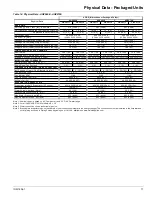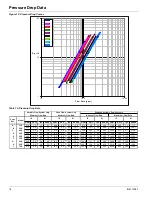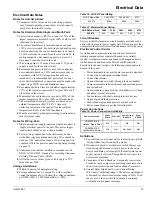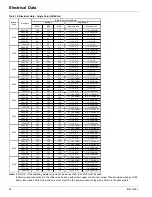
IOM 1206-1
9
Installation and Application Information
Low Ambient Operation
Compressor staging is adaptively determined by system load,
ambient air temperature, and other inputs to the MicroTech III
control. A low ambient option with fan VFD allows operation
down to -10° F (-23° C). The minimum ambient temperature is
based on still conditions where the wind is not greater than
five mph. Greater wind velocities will result in reduced
discharge pressure, increasing the minimum operating ambient
temperature. Field installed hail/wind guards are available to
allow the chiller to operate effectively down to the ambient
temperature for which it was designed.
High Ambient Operation
AGZ-E units for high ambient operation (104ºF to 125ºF,
40ºC to 52ºC) require the addition of the optional high ambient
package that includes a small fan with a filter in the air intake
to cool the control panel.
All units with the optional VFD low ambient fan control
automatically include the high ambient option.
Flow Switch
All chillers require a chilled water flow switch to check that
there is adequate water flow through the evaporator ant to shut
the unit down if there isn't. There are two options for meeting
this requirement.
1
A factory-mounted thermal dispersion flow switch.
2
A "paddle" type flow switch is available from Daikin
Applied (part number 017503300) for field mounting
and wiring.
Wire from switch terminals Y and R to the
unit control panel terminals shown on the field wiring
diagrams,
page 21
and
page 22
. Mount the flow switch in
the leaving water line to shut down the unit when water
flow is interrupted. A flow switch is an equipment
protection control and should never be used to cycle a
unit.
Installation should be per manufacturer's instructions included
with the switch. Flow switches should be calibrated to shut off
the unit when operated below the minimum listed flow rate for
the unit as listed on
page 18
.
There is also a set of normally closed contacts on the switch
that can be used for an indicator light or an alarm to indicate
when a "no flow" condition exists. Freeze protect any flow
switch that is installed outdoors. Differential pressure switches
are not recommended for outdoor installation. They can freeze
and not indicate a no-flow conditions.
Glycol Solutions
The use of a glycol/water mixture in the evaporator to prevent
freezing will reduce system capacity and efficiency, as well as
increase pressure drop. The system capacity, required glycol
solution flow rate, and pressure drop with glycol may be
calculated using the following formulas and tables.
1
Capacity
- Multiply the capacity based on water by the
Capacity correction factor from
Table 3
or
Table 4
.
2
Flow
- Multiply the water evaporator flow by the Flow
correction factor from
Table 3
or
Table 4
to determine
the increased evaporator flow due to glycol. If the flow is
unknown, it can be calculated from the following
equation:
3
Pressure drop
- Multiply the water pressure drop from
Table 15, page 18
by Pressure Drop correction factor
from
Table 3
or
Table 4
. High concentrations of
propylene glycol at low temperatures may cause
unacceptably high pressure drops.
4
Power
- Multiply the water system power by Power
correction factor from
Table 3
or
Table 4
.
Test coolant with a clean, accurate glycol solution hydrometer
(similar to that found in service stations) or refractto determine
the freezing point. Obtain percent glycol from the freezing
point table below. It is recommended that a minimum of 25%
solution by weight be used for protection against corrosion or
that additional compatible inhibitors be added. Concentrations
above 35% do not provide any additional burst protection and
should be carefully considered before using.
Table 3: Ethylene Glycol Factors
Table 4: Propylene Glycol Factors
Factor
Correction
Flow
T
Delta
ns
CapacityTo
×
−
×
=
00429
.
0
(gpm)
Flow
Glycol
CAUTION
Do not use an automotive-grade antifreeze. Industrial grade glycols must be used. Automotive antifreeze contains inhibitors
which will cause plating on the copper tubes within the chiller evaporator. The type and handling of glycol used must be
consistent with local codes.
% E.G.
Freeze Point
Capacity
Power
Flow
PD
o
F
o
C
10
26
-3.3
0.998
0.998
1.036
1.097
20
18
-7.8
0.993
0.997
1.060
1.226
30
7
-13.9
0.987
0.995
1.092
1.369
40
-7
-21.7
0.980
0.992
1.132
1.557
50
-28
-33.3
0.973
0.991
1.182
1.791
% P.G.
Freeze Point
Capacity
Power
Flow
PD
o
F
o
C
10
26
-3.3
0.995
0.997
1.016
1.100
20
19
-7.2
0.987
0.995
1.032
1.211
30
9
-12.8
0.978
0.992
1.057
1.380
40
-5
-20.6
0.964
0.987
1.092
1.703
50
-27
-32.8
0.952
0.983
1.140
2.251










































